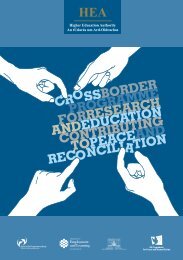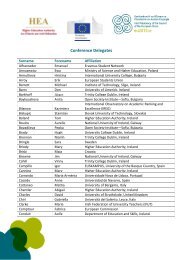Key Facts and Figures 0607 - Higher Education Authority
Key Facts and Figures 0607 - Higher Education Authority
Key Facts and Figures 0607 - Higher Education Authority
You also want an ePaper? Increase the reach of your titles
YUMPU automatically turns print PDFs into web optimized ePapers that Google loves.
INTERNATIONAL PERSPECTIVE<br />
This section contains a comparative perspective of graduate output in<br />
selected OECD countries.<br />
Figure 5.3 Percentage of Tertiary Type B Graduates to the Population at Typical Age of<br />
Graduation 2005 for selected OECD Countries<br />
30<br />
25<br />
20<br />
15<br />
10<br />
5<br />
0<br />
Italy<br />
Pol<strong>and</strong><br />
Norway<br />
Slovak Republic<br />
Hungary<br />
Icel<strong>and</strong><br />
Sweden<br />
Czech Republic<br />
Austria<br />
Denmark<br />
United States<br />
Germany<br />
Spain<br />
United kingdom<br />
Irel<strong>and</strong><br />
Japan<br />
SECTION FIVE / GRADUATE DATA<br />
Source: <strong>Education</strong> at a Glance 2007, OECD<br />
Tertiary Type B graduates correspond to <strong>Higher</strong> Certificate, University Certificate, Ordinary<br />
Degree <strong>and</strong> University Diploma graduates.<br />
<br />
The mean for selected OECD countries is just over 9%. At 24%, graduation rates from<br />
tertiary type B programmes in Irel<strong>and</strong> are notably higher than in other selected OECD<br />
countries. While this difference is considerable, it is important to note that Tertiary<br />
Type B programmes may differ in length in different countries <strong>and</strong> in turn impact on<br />
the participation <strong>and</strong> graduation rates.<br />
49
















